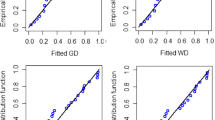Abstract
This paper proposes an inferential method for the semiparametric proportional hazards model for progressively Type-II censored data. We establish martingale properties of counting processes based on progressively Type-II censored data that allow to derive the asymptotic behavior of estimators of the regression parameter, the conditional cumulative hazard rate functions, and the conditional reliability functions. A Monte Carlo study and an example are provided to illustrate the behavior of our estimators and to compare progressive Type-II censoring sampling plans with classical Type-II right censoring sampling plan.
Similar content being viewed by others
References
Ahn H., Zhu W., Yang J., Kodell R.L. (1998) Efficient designs for animal carcinogenicity experiements. Communication in Statistics: Theory and Methods 27: 1275–1288
Alvarez-Andrade S., Bordes L. (2004) Empirical quantile process under Type-II progressive censoring. Statistics and Probability Letters 68: 111–123
Andersen P.K., Gill R. (1982) Cox’s regression model for counting processes: a large sample study. The Annals of Statistics 10: 1100–1120
Andersen P.K., Borgan O., Gill R., Keiding N. (1993) Statistical models based on counting processes. Springer, New York
Aven T., Jensen U (1999) Stochastic models in reliability. Springer, New York
Balakrishnan N., Aggarwala R. (2000) Progressive censoring: theory, methods, and applications. Birkhäuser, Boston
Balakrishnan N., Bordes L. (2004) Non-parametric hazard rate estimation under progressive type-II censoring. In: Balakrishnan N., Rao C.R.(eds) Handbook of statistics: advances in survival analysis, Vol.23.. North-Holland, Amsterdam, pp 227–249
Balakrishnan N., Kannan N., Lin C.-T., Ng H.K.T. (2003) Point and interval estimation for Gaussian distribution, based on progressively Type-II censored samples. IEEE Transactions on Reliability 52: 90–95
Balakrishnan N., Kannan N., Lin C.-T., Wu S.J.S. (2004) Inference for the extreme value distribution under progressive Type-II censoring. The Journal of Statistical Computation and Simulation 74: 25–45
Balakrishnan N., Ng H.K.T., Kannan N. (2004) Goodness-of-fit tests based on spacings for progressively Type-II censored data from a general location-scale distribution. IEEE Transactions on Reliability 53: 349–356
Balasooriya U., Balakrishnan N. (2000) Reliability sampling plans for lognormal distribution, based on progressively-censored samples. IEEE Transactions on Reliability 49: 199–203
Balasooriya U., Saw S.L.C., Gadag V. (2000) Progressively censored reliability sampling plans for the Weibull distribution. Technometrics 42: 160–167
Basak I., Balakrishnan N. (2003) Robust estimation under progressive censoring. Computational Statistics & Data Analysis 44: 349–376
Bordes L. (2004) Non-parametric estimation under progressive censoring. Journal of Statistical Planning and Inference 119: 171–189
Cox D.R. (1972) Regression models and life-tables (with discussion). Journal of the Royal Statistical Society B 34: 187–220
Cox D.R. (1975) Partial likelihood. Biometrika 62: 269–276
Gill R.D. (1989) Non- and semi-parametric maximum likelihhod estimators and the von Mises method (Part 1). Scandinavian Journal of Statistics 16: 97–128
Guilbaud O. (2001) Exact non-parametric confidence intervals for quantiles with progressive Type-II censoring. Scandinavian Journal of Statistics 28: 699–713
Guilbaud O. (2004) Exact non-parametric confidence, prediction and tolerance intervals with progressive Type-II censoring. Scandinavian Journal of Statistics 31: 265–281
Kamps U. (1995) A concept of generalized order statistics. Journal of Statistical Planning and Inference 48: 1–23
Montanari G.C., Cacciari M. (1988) Progressively-censored aging tests on XLPE-insulated cable mo\ls. IEEE Transactions on Electrical Insulation 23: 365–372
Nelson W. (1990) Accelerated testing. Wiley, New York
Ng H.K.T., Chan P.S., Balakrishnan N. (2002) Estimation of parameters from progressively censored data using EM algorithm. Computational Statistics & Data Analysis 39: 371–386
Ng H.K.T., Chan P.S., Balakrishnan N. (2004) Optimal progressive censoring scheme for Weibull distribution. Technometrics 46: 470–481
Viveros R., Balakrishnan N. (1994) Interval estimation of life characteristics from progressively censored data. Technometrics 36: 84–91
Author information
Authors and Affiliations
Corresponding author
About this article
Cite this article
Alvarez-Andrade, S., Balakrishnan, N. & Bordes, L. Proportional hazards regression under progressive Type-II censoring. Ann Inst Stat Math 61, 887–903 (2009). https://doi.org/10.1007/s10463-008-0170-8
Received:
Revised:
Published:
Issue Date:
DOI: https://doi.org/10.1007/s10463-008-0170-8




